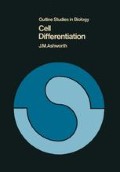Abstract
In the preceding sections it has been assumed, more or less explicitly, that cell differentiation is fundamen tally a problem of differential gene activity i.e. different genes are active in different cell types but all cells have the same genetic information. In model systems such as the phage, sporulation and spore germination, where there is only one cell involved, the problem rnust clearly be one of time dependent changes in gene activity, but in multicellular, and especially embryonic systems, this is not so obvious. Indeed Weismann in the 19th century suggested that the origin of differences between embryonic cells had to do with differences in what he termed their ‘nucleoplasm’. The simplest hypothesis, he suggested, ‘would be to suppose that at each division of the nucleus, its specific substance divides into two halves of unequal quality, so that the cell-bodies would also be transformed ...’ Of course such an ordered parcelling out of genes amongst the cells of the embryo must leave the germ cells unaffected and so Weismann’s theory also necessitated a qualitative distinction between the somatic and the germ cells.
Access this chapter
Tax calculation will be finalised at checkout
Purchases are for personal use only
Preview
Unable to display preview. Download preview PDF.
References
Barth, L. J. (1964), Development: Selected topics, Addison Wesley, London.
Paigen, K. (1971), In Enzyme Synthesis and Degradation in Mammalian Systems,Karger, Basel, 1 – 46.
Callan, H. G. (1967),1. Cell Sci., 2, 1–7.
Thomas, C. A. (1970), In The Neurosciences:Second Study Program, Rockefeller University Press, New York, 973 – 998.
Ris, H. and Kubai, D. F. (1970),Adv. In Genetics, 4, 263–294 1970.
Beerman, W. (1961), Chromosoma, 12, 1 – 25.
Grossbach, U. (1968),Ann. Zool. Fennici., 5, 37.
Huang, R. C. C. and Kleiman, L. (1971), Symp. Soc. Exp. Bioi., 25, 93 – 115.
Paul, J. and Gilmour, R. S. (1968), J. Mol.Bioi., 34, 305 – 316.
Dixon, G. H. and Sung, M.T. (1970),Proc. Nat. A cad. Sci., (US), 67,1616–1623.
Langan, T. A. (1968), Science, 162,579 – 580 1968.
Gall, J. and Pardue, M. L. (1969),Proc. Nat. A cad. Sci., (US), 63, 378–383.
Brown, D. D. and Dawid, I. B. (1968), Science, 160, 272 – 280.
Miller, O. L. and Beatty, B. R. (1969), Science, 164, 955 – 957.
Loening, D.E. (1970), Symp. Soc. gen. Microbiol., 20, 77 – 106.
Pemberton, R. E., Housman, D., Lodish, H. F. and Baglioni, C. (1972),Nature, 235, 99 – 102.
Heywood, S. M. and Rich, A. (1968), Proc. Nat. A cad. Sci. (US), 59, 590–597.
Kedes, L. H. and Gross, P. (1969), Nature, 223, 1335 – 1339.
Kedes, L. H. and Birnsteil, M. L. (1971), Nature, 230, 165 – 169 1971
Bishop, J. 0., Pemberton, R. and Baglioni, C. (1972), Nature, 235, 231 – 234.
Harris, H. (1969), Cell Fusion, Oxford University Press, Oxford.
Felicetti, L., Gambino, R., Metafore, S. and Monroy, A. (1971), Symp. Soc. Exp. Bio!., 25, 183 – 186.
Heywood, S. M. (1970), Nature, 225, 696 – 698.1970
Lim, L. and Canellakis, E. G. (1970), Nature, 227, 710 – 712.
Williamson, A. (1969), In Essays in Biochemistry,5, 139–175.
Schimke, R. T. (1969), In Current Topics in Cellular Regulation, 1, 77 – 124.
Markert, C. L. and Ursprung, H. (1971), Developmental Genetics, Prentice-Hall Inc., London. 1971
Wuntch, T., Chen, R. F. and Vessell, E. S. (1970), Science, 167, 63 – 65.
Srere, P. A. (1967), Science, 158,936937 and erratum on p. 1556.
Brew, K. (1970), In Essays in Biochemistry, 6, 93 – 118.
Ashworth, J. M. (1971), Symp. Soc. Exp. Bio., 25, 27 – 50.
Hess, B., Boiteux, A. and Kruger, J. (1969), InAdvances in Enzyme Regulation, 7, 149167.
Author information
Authors and Affiliations
Rights and permissions
Copyright information
© 1973 J.M. Ashworth
About this chapter
Cite this chapter
Ashworth, J. (1973). Special systems, the classical approach. In: Cell Differentiation. Outline Studies In Biology. Springer, Dordrecht. https://doi.org/10.1007/978-94-009-5713-8_4
Download citation
DOI: https://doi.org/10.1007/978-94-009-5713-8_4
Publisher Name: Springer, Dordrecht
Print ISBN: 978-0-412-11760-2
Online ISBN: 978-94-009-5713-8
eBook Packages: Springer Book Archive

